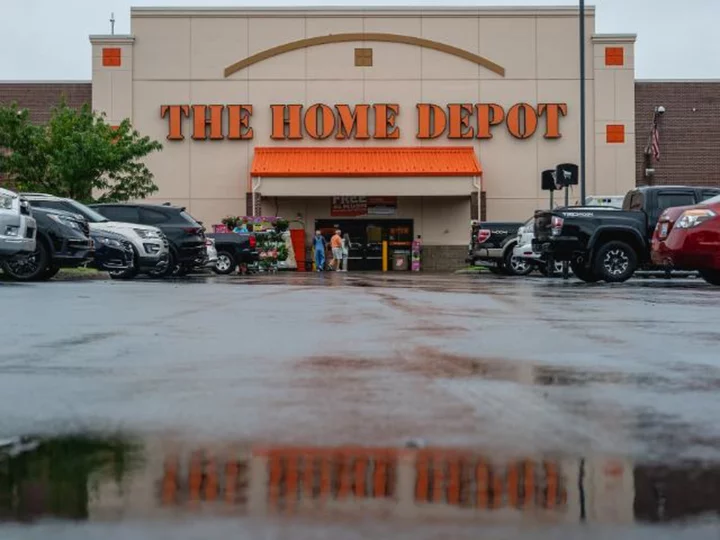SACRAMENTO, Calif.--(BUSINESS WIRE)--Oct 30, 2023--
In accordance with California’s Proper Labeling of Wet Wipes law ( AB818 ), the California Association of Sanitation Agencies ( CASA ), the Responsible Flushing Alliance ( RFA ), and the Association of the Nonwoven Fabrics Industry ( INDA ), have partnered to conduct a sewage collection study to help determine what is clogging sewer lines and equipment across the state.
This press release features multimedia. View the full release here: https://www.businesswire.com/news/home/20231030098107/en/
Identifying a fully intact baby wipe at the Central Contra Costa Sanitary District's collection study to determine which flushing habits can cause clogs in sewer lines and damage machinery. Always look for the "Do Not Flush" symbol on wipes packaging and follow disposal instructions to keep non-flushables out of the sewers. (Photo: Business Wire)
“As a co-sponsor of the Proper Labeling of Wet Wipes law, we recognized the importance of educating Californians about not treating their toilets as a trashcan,” said Adam Link, Executive Director of CASA. “We’ve all seen the huge rag balls pulled from clogged sewer lines, and through this study we are taking a forensic approach by untangling those products and determining what is actually being flushed. These efforts will help inform our educational outreach.”
The two locations for the study include the Inland Empire Utilities Agency ( IEUA ) in Southern California and Central Contra Costa Sanitary District ( Central San ) in the greater San Francisco Bay Area in Northern California. The collections and forensic analysis are underway with the “dry season” studies taking place this month and the “wet season” studies taking place this winter, if required pending dry season final results outcome.
What’s Being Flushed?
Preliminary collection study results from IEUA (Oct. 11-12) and Central San (Oct. 17-18) showed 94 percent of items collected were paper (53%), wipes labeled with the “Do Not Flush” symbol (34%), and feminine hygiene products (7%). Less than 1 percent of items collected so far were considered to be flushable wipes. The baby wipes and other non-flushable items were found mostly fully intact.
Some of the more unusual items collected include an action figure, hair weave, pet mouse, banana peel, a knee sock, rubber bands, cloth towels, and a plastic toy frog. Also observed before the collection period started were other toys, syringes, condoms, and underwear.
“With approximately 90 percent of wipes sold in the U.S. being non-flushable, it makes looking for the ‘Do Not Flush’ symbol and following disposal instructions exceptionally important,” said Responsible Flushing Alliance President Lara Wyss. “Non-flushable wipes are engineered to be different from flushable wipes. Non-flushable wipes are made with long, often plastic fibers that are meant to be strong. Flushable wipes are made with 100 percent plant-based fibers and are designed to break down in water, similar to toilet paper. 1 ”
How the Study is Conducted
Kennedy-Jenks, an independent engineering firm, was hired to design the collection study and compile the findings in a report, due during the first half of 2024. Study parameters include pulling raw sewage samples from the headworks during peak flow times. Analysis of the items spans four days of sorting with more than 1,700 items identified in the “dry season” sample alone.
“To make accurate identifications, we purchased over 150 wipes brands and types to compile a sample book for comparing markings and patterns,” said Matt O’Sickey, PhD, INDA’s Director of Education & Technical Affairs. “We also enlisted the expertise of technical leaders and material scientists from INDA member companies to lead the identifications of wipes and other items. By using a magnifying glass, gently pulling at the fibers and examining them, as well as comparing them to our sample book, we are individually inspecting each item carefully.”
Categories for items identified include all baby wipes and other non-flushable wipes outlined in the Proper Labeling of Wet Wipes law, feminine hygiene products, flushable wipes (moist toilet tissue), and non-flushable paper products (paper towels, wrappers).
Once collected, sample items are separated, identified, and documented by taking a picture of each piece and writing its description in a collection logbook. A count of one item is considered any material measuring one inch or more in two dimensions.
What Not to Flush and Consumer Outreach
“There is a lot of consumer confusion around what should or should not be flushed and that’s where our consumer education campaign, #FlushSmart, comes into play,” Wyss said. “We surveyed Californians about what they are flushing 2. The results showed that 20 percent mistakenly think all soft paper products can be flushed and approximately 25 percent think baby wipes are flushable, which is never true. Even worse, 60 percent self-reported they flushed something they knew they shouldn’t.”
According to the Proper Wet Wipes Labeling law, manufacturers of non-flushable wipes, including products such as baby wipes, cleaning wipes, makeup removal wipes, and many others, that are primarily used in a bathroom setting must include the “Do Not Flush” symbol on the front of packaging. The #FlushSmart consumer education campaign promotes the “Do Not Flush” symbol and provides information on what should and should not be flushed.
Here is a list of common household items that should never be flushed:
- Baby Wipes or Household Cleaning Wipes
- Paper Towels, Facial Tissue, Makeup Wipes
- Fats, Oils, and Grease (FOG)
- Food, Trash, Plastic Bags
- Rags, Cloth, Disposable Gloves
- Cotton Balls, Cotton Swabs, Dental Floss
- Feminine Products
- Hair/Hair Weaves
- Medications/Syringes
Each year there are a significant number of sanitary sewer spills, and many are caused by the introduction of non-flushable products into the wastewater system. Wastewater spills can be a potential threat to public health and the environment, and it is estimated that local public agencies throughout California (and the ratepayers they represent) are spending more than $47 million 3 annually on repairing wastewater treatment equipment and responding to sewer overflows caused by inappropriately flushing wet wipes.
About California Association of Sanitation Agencies
CASA represents more than 125 local public agencies engaged in the collection, treatment and recycling of wastewater and biosolids to protect public health and the environment. Our mission is to provide trusted information and advocacy on behalf of California clean water agencies, and to be a leader in sustainability and utilization of renewable resources.
About Responsible Flushing Alliance
The Responsible Flushing Alliance (RFA) is a 501(c)(6) non-profit organization dedicated to consumer education focused on what not to flush. RFA’s goal is to change consumer behavior to help reduce damage to our nation’s sewage systems caused by objects and materials not designed to be flushed. For more information, visit https://flushsmart.org or on Facebook, TikTok, Instagram, and X (formerly Twitter).
About INDA
Founded in 1968, INDA member companies represent the entire nonwovens value-chain. From raw materials and roll goods producers, to machinery manufacturers and converters, to brand owners, we work each day to fulfill our mission of “fostering member and industry success through its activities.” We do this by providing thought-leadership in Innovation & Technology through conference content, recognition awards and industry reports; protecting markets that are important to our members through focused Product Stewardship; advocating for industry sectors impacted by regulatory or consumer driven issues; organizing face-to-face interaction through industry expositions and events to facilitate the advancement of each participant’s interests; recruiting, educating and training industry members through strengthened outreach and broadening of on-site and on-line courses relevant to experience levels and market segments; and enhancing access to new markets through international activities.
1 Infographic on different types of wipes: https://www.flushsmart.org/wp-content/uploads/Update_EN.pdf
2https://www.prweb.com/releases/new-survey-finds-consumers-still-disposing-non-flushable-items-down-the-toilet-sparking-increase-in-consumer-education-efforts-847221681.html
3https://www.nacwa.org/docs/default-source/resources---public/govaff-3-cost_of_wipes-1.pdf?sfvrsn=b535fe61_2
View source version on businesswire.com:https://www.businesswire.com/news/home/20231030098107/en/
CONTACT: Lara Wyss, RFA,lara@flushsmart.org
Alyssa Downs, CASA,adowns@casaweb.org
Misty Ayers, INDA,mayers@inda.org
KEYWORD: CALIFORNIA UNITED STATES NORTH AMERICA
INDUSTRY KEYWORD: RESEARCH UTILITIES PHILANTHROPY ENVIRONMENTAL HEALTH CONSUMER ENERGY STATE/LOCAL ENVIRONMENT FOUNDATION OTHER CONSUMER SCIENCE PUBLIC POLICY/GOVERNMENT
SOURCE: Responsible Flushing Alliance
Copyright Business Wire 2023.
PUB: 10/30/2023 09:15 AM/DISC: 10/30/2023 09:17 AM
http://www.businesswire.com/news/home/20231030098107/en









